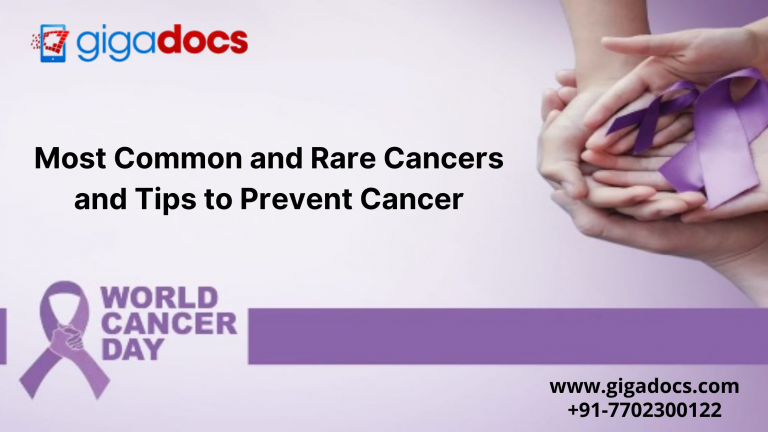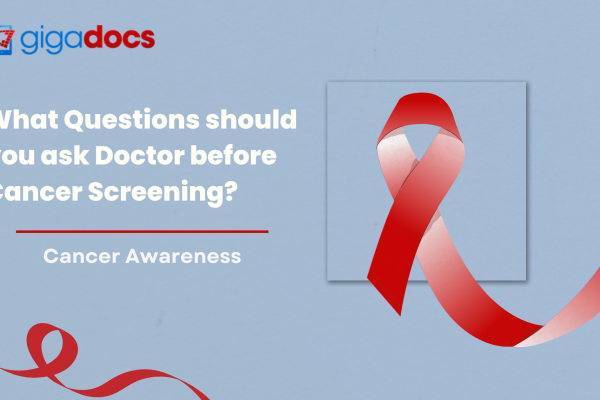Breast cancer is one of over 200 different types of cancers that have been identified, and it is one of the most common types of cancer. On World Cancer Day, we bring to you the most common and rare types of cancer that affect people worldwide.
Common Cancers
- Breast cancer
Breast cancer is one of the most commonly diagnosed cancers affecting females worldwide. Females have a 90% five-year survival rate.
- Cancer of the lungs (including bronchus)
Another leading cause of death is lung cancer, which happens worldwide. Stop smoking if you want to reduce your lung and bronchus cancer risk. The five-year survival rate of lung and bronchus cancer is 23%.
- Cancer of the prostate
Prostate cancer, typically slow-growing, is common cancer, with a 5-year survival rate of 98 percent.
- Rectal and colon cancer
Colorectal cancer is the name given to the collective, colon, or rectum cancers. They form the large intestine when combined. The five-year survival rate is 64%.
- Melanoma (skin)
Melanoma is a type of cancer that begins in the specialized cells responsible for producing the pigment called melanin that gives the skin its color. Melanoma is more common on the skin, but it can also develop in the eye and other pigmented tissues. The five-year survival rate has been 92%.
- Cancer of the Bladder
Bladder cancer typically affects older adults and is more common in men than women. 77% is the five-year survival rate.
- Non-Hodgkin lymphoma
Non-Hodgkin lymphoma begins in the lymphatic system. It is characterized by developing lymphocyte tumors, which are a kind of white blood cell. 71% is the five-year survival rate.
- Cancer of the kidney (renal cell and renal pelvis)
Renal cell carcinoma is a type of kidney cancer that typically manifests as a single tumor in one kidney. Renal pelvic cancer develops in the pelvis of the kidney or the ureter. That is the tube that moves urine from the kidney to the bladder. 75% is the five-year survival rate.
- Cancer of the endometrium
Uterine cancer is classified into two types. Endometrial cancer is common, but uterine sarcoma is uncommon. The five-year survival rate for this cancer is 84%.
- Leukemia
Leukemias are cancers that begin in the blood-forming tissue of the bone marrow. These cancers are distinguished by an abnormal accumulation of white blood cells in the blood and bone marrow by displacing the normal blood cells. As a result, the body’s ability to distribute oxygen to the different organs, fight infections, and control bleeding are compromised. Sixty-one percent of people live for more than 5 years on an average.
- Cancer of the pancreas
Pancreatic cancer typically starts in the pancreas and quickly spreads to nearby organs. The five-year survival rate is nine percent.
- Cancer of the thyroid
The treatment of anaplastic thyroid cancer is challenging. However, thyroid cancers such as follicular, medullary, and the most common type, papillary, are usually treated with success. That explains the 5-year survival rate of 100%.
- Cancer of the liver and the intrahepatic bile duct
Hepatocellular carcinoma is the most common type of liver cancer, followed by bile duct cancer (cholangiocarcinoma) and hepatoblastoma. Hepatocellular carcinoma is associated with liver cirrhosis and chronic hepatitis B or C infection. The five-year survival rate is 18%.
Rare Cancers
Cancer is a complicated subject, and there is currently no universal definition of what constitutes rare cancer. A particular type of cancer may be rare because it occurs less frequently in certain demographic groups than others. They can affect both children and adults. Rare cancer symptoms can vary greatly depending on which organs and tissues are affected. Surgery, chemotherapy, and radiation are frequently used in treatment, but other therapies or symptom management may be used as well.
There are numerous types of rare cancer. However, each type is only diagnosed in a small number of people, which includes-
- Esophageal cancer
The tube that transports food and beverages from the throat to the stomach is affected by esophageal cancer. The 5-year survival rate for a localized tumor ranges from 47 percent to 5 percent for Esophageal cancer.
- Myeloid leukemia
Chronic myeloid leukemia (CML) causes an abnormally high number of blood cells produced by the bone marrow. There is no reliable information on the prognosis for people with CML, but one study found that 90 percent of those who received this treatment were still alive after five years.
- Acute lymphoblastic leukemia in children
Childhood acute lymphoblastic leukemia is a type of bone marrow and blood cancer. While it is uncommon, it is the most common cancer in children. Children have a 5-year survival rate of around 90%.
- Anal cancer
The anus, or opening at the end of the rectum, is the site of anal cancer. It is less common than cancers of the colon or rectum. The 5-year survival rate for localized tumors ranges from 82 percent to 34 percent for metastasized tumors.
- ● Merkel cell carcinoma
Merkel cell carcinoma is also known as trabecular cancer or neuroendocrine carcinoma of the skin. The average 5-year relative survival rate for Merkel cell carcinoma across all stages is 63%.
- Thymic carcinoma
Thymic carcinoma is a type of cancer that can develop in the thymus, a small organ in the upper chest that produces white blood cells. Thymic carcinoma cells proliferate rapidly and have a high propensity to spread to other parts of the body, such as the lungs. The 5-year mortality rate for locally advanced, inoperable carcinoma is 36%. The survival rate of carcinoma spread to other body parts is 24%.
- Hepatoblastoma
A hepatoblastoma is a type of liver cancer that usually develops in the first three years of life. The 5-year survival rate for children was 81.5 percent on average.
- Glioblastoma
Glioblastoma is a type of brain tumor that is typically aggressive. Many people die within a year of receiving a diagnosis.
- Ewing sarcoma
Ewing sarcoma is a type of cancer that usually develops in bone tissue. This cancer is most common in children and young adults. The 5-year survival rate for all stages of Ewing sarcoma is 61%.
- Kaposi sarcoma
Kaposi sarcoma is a type of cancer that develops in the cells that line lymphatic or blood vessels. Kaposi sarcoma has a 5-year relative survival rate of 73%.
| World Cancer Day World Cancer Day is the only initiative that allows the entire world to join forces to fight against the global cancer epidemic. Every year on February 4th, World Cancer Day aims to save millions of lives by increasing cancer awareness, educating and pressuring governments and individuals around the world to take action against the disease. |
Preventing Cancer
- Quit smoking and avoid being exposed to other people’s smoke. Tobacco use can lead to cancer throughout the body, not just in the lungs.
- Maintain a healthy weight and exercise regularly. Obesity and being overweight have been linked to at least 13 different types of cancer.
- Obtain the cancer screening tests that are appropriate for you. Screening tests can detect breast, cervical, and colorectal cancers early.
- Vaccinate your children against HPV when they are 11 or 12 years old. The human papillomavirus (HPV) vaccine can prevent a wide range of cancers later in life.
- Assist your children in protecting their skin from the sun. UV rays and tanning beds can cause skin cancer.
- Make sure that your children eat well and are physically active. Maintaining a healthy weight reduces their risk of cancer and other health problems.
Gigadocs and Cancer care
Gigadocs is an intelligent practice management software solution that can handle all of your digital healthcare management needs. You can record and save your vitals, such as heart rate and pulse count, and share them with your medical specialist in real-time.
On the Gigadocs app, you can book the best oncologist and consult with them digitally from the safety of your own home.
Download the Gigadocs app to book appointments with the best doctors around you:
IOS App – apple.co/2W2iG4V
Android App – bit.ly/33AQoRC
To know more e-mail, at info@gigadocs.com




